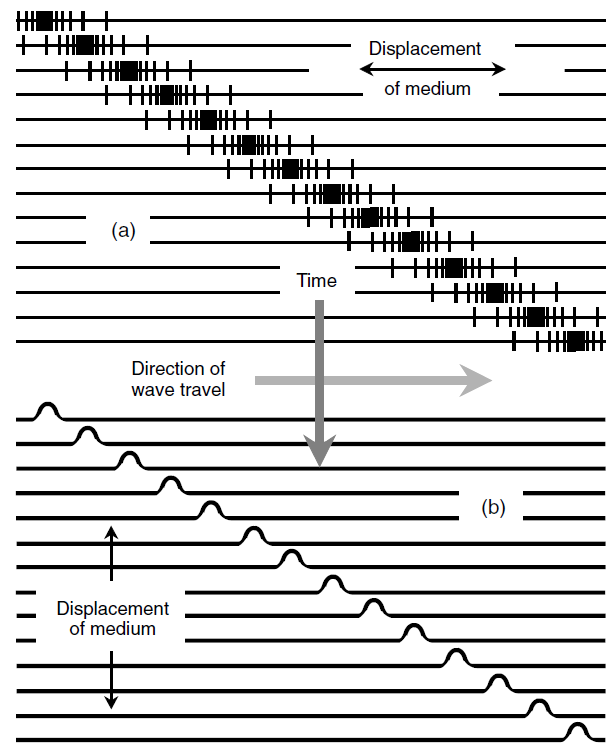


 الفيزياء الكلاسيكية
الفيزياء الكلاسيكية
 الكهربائية والمغناطيسية
الكهربائية والمغناطيسية
 علم البصريات
علم البصريات
 الفيزياء الحديثة
الفيزياء الحديثة
 النظرية النسبية
النظرية النسبية
 الفيزياء النووية
الفيزياء النووية
 فيزياء الحالة الصلبة
فيزياء الحالة الصلبة
 الليزر
الليزر
 علم الفلك
علم الفلك
 المجموعة الشمسية
المجموعة الشمسية
 الطاقة البديلة
الطاقة البديلة
 الفيزياء والعلوم الأخرى
الفيزياء والعلوم الأخرى
 مواضيع عامة في الفيزياء
مواضيع عامة في الفيزياء|
Read More
Date: 13-7-2017
Date: 12-9-2020
Date: 29-10-2020
|
LENGTHWISE VERSUS SIDEWAYS
When waves travel through matter, the molecules oscillate to and fro, up and down, or back and forth. The nature of the particle movement differs from the nature of the wave as it travels. The atoms or molecules rarely move more than a few meters—sometimes less than a centimeter—but the wave can travel thousands of kilometers. Sometimes the particles vibrate in line with the direction of wave travel; this is a compression wave, also called a longitudinal wave. In other instances, the particles move at right angles to the direction of propagation; this is a transverse wave. The distinction is illustrated in Fig. 1.
What is it that wags or wiggles or compresses or stretches when a wave travels through a particular medium? It depends on the medium and on the nature of the wave disturbance. Sound waves in air are longitudinal, but radio waves are transverse. The waves on the surface of the ocean are transverse, but when a big wave arrives on a beach, plenty of longitudinal motion is involved as well.

Fig. 1. In a longitudinal wave (a), the particles vibrate parallel to the direction of wave travel. In a transverse wave (b), the particles vibrate laterally.



|
|
|
|
دخلت غرفة فنسيت ماذا تريد من داخلها.. خبير يفسر الحالة
|
|
|
|
|
|
|
ثورة طبية.. ابتكار أصغر جهاز لتنظيم ضربات القلب في العالم
|
|
|
|
|
|
|
سماحة السيد الصافي يؤكد ضرورة تعريف المجتمعات بأهمية مبادئ أهل البيت (عليهم السلام) في إيجاد حلول للمشاكل الاجتماعية
|
|
|